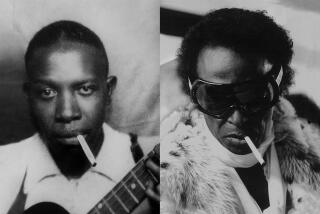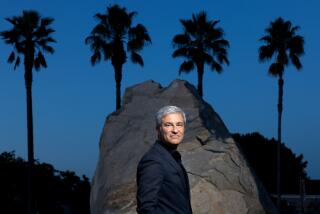Art Windfall
- Share via
In a windfall of artworks that couldn’t have been acquired any other way, the Museum of Contemporary Art in Los Angeles announced Wednesday that it will receive a gift of 105 works by 53 artists from the Lannan Foundation, which is in the process of dispersing its landmark contemporary art collection.
The donation--valued by the foundation at more than $2 million and tailored to fit MOCA’s artistic mission--will significantly enrich the museum’s 4,000-piece holding of postwar art. The gift is the latest in a series of donations and savvy purchases that has built the youthful museum’s collection with astonishing speed.
Encompassing a wide range of art movements, many of the Lannan works are pivotal examples by Southern California artists acquired by the foundation and its late founder, J. Patrick Lannan, since the 1950s. The museum’s limited acquisition fund would have precluded purchasing such a large group of works at once.
“This extraordinary gift sets a foundation for the future,” museum Director Richard Koshalek said. “It will have a tremendous impact on the development of our permanent collection and allow us to use our collection in new ways.”
MOCA staff members said the importance of the artworks far outweighs their relatively modest dollar value.
“This gift fits our program to a greater degree than any other we have received,” chief curator Paul Schimmel said. “Many of the pieces are by artists with whom MOCA has had an extensive history. We got outstanding pieces by some of the brightest people who have not yet received the recognition they deserve.”
Among the most important acquisitions are sculptor Chris Burden’s “Big Wheel,” a massive kinetic work powered by a motorcycle; two translucent discs and five early paintings by Robert Irwin, whose perceptual explorations were key to the development of Light and Space art; Charles Ray’s “Tabletop,” composed of a wood table strewn with ordinary objects that rotate at an imperceptibly slow pace; and 14 collages and mixed media objects by Beat artist Wallace Berman.
The much-anticipated announcement of the Lannan collection’s dispersal follows the Los Angeles-based foundation’s controversial shift of its philanthropic focus from contemporary art to Native American communities. Established in 1960 by Lannan--a self-educated entrepreneur who directed International Telephone and Telegraph for 36 years--the $170-million foundation is now headed by his son, J. Patrick Lannan Jr.
Since his father’s death in 1983, Lannan has overseen the foundation’s model programs of art collecting, exhibitions and nationwide grants. But in the last three years, he directed the foundation to stop buying art, closed its elegant Westside exhibition space and implemented a plan to disperse the collection through gifts and sales to museums. At the same time, more Lannan funds have been channeled into support of American Indian projects.
Critics have raised questions about the ethics of such a radical change after the death of the founder, who was an avid supporter of the arts but left only vague guidelines for his foundation. But MOCA’s administrators and staff are thrilled with their windfall.
Representing selected artists in depth, the foundation’s philosophy and goals paralleled those of MOCA, making the gift remarkably appropriate, curator Ann Goldstein said.
“We now have a complete collection of works by Robert Irwin,” Koshalek said, referring to one of the museum’s original trustees who was the subject of a MOCA-organized, traveling retrospective in 1993.
Irwin, who has been busy with a large-scale outdoor project he is constructing at the Getty Center in Brentwood, said he is pleased to be so well represented at MOCA. “I’m thrilled that things have worked out as well as they have,” he said. “I got involved with MOCA because I thought the artists of L.A. deserved more than they got.”
The Los Angeles museum and Chicago’s Art Institute and Museum of Contemporary Art were offered first choice of Lannan gifts and purchases. MOCA will make a decision about purchases in two or three weeks, Koshalek said.
The two Chicago institutions plan to announce their Lannan gifts in mid- to late February. The Museum of Contemporary Art in Chicago does not have funds to buy artworks, Director Kevin Consey said. The Art Institute has not revealed its plans regarding Lannan purchases.
The museums were given a list of about 550 objects available for donation and 53 for sale. Prospective recipients prioritized their choices and provided written explanations of how the works would fit their collections. MOCA received 105 of the 180 pieces it requested. Sources close to the foundation say the Chicago museums asked for fewer items.
Lannan was traveling and could not be reached for comment, but in a mid-December interview he said works not donated or sold to the three institutions would be offered to other museums and that none of the art would be put up for auction.
For MOCA, the donation provides significant bodies of work by artists it has exhibited, including Burden, Ray, Mike Kelley, Jim Shaw, John M. Miller and Kiki Smith. In addition, the museum has received its first pieces by two dozen other artists, including Siah Armajani’s installation “Back Porch With Picnic Table,” and three large drawings by Jay Defeo.
The gift continues MOCA’s tradition of snagging important established collections. In 1984, two years before opening its main building on Grand Avenue, the museum purchased 80 Abstract Expressionist and Pop works from Italian collector Count Giuseppe Panza di Biumo. Even then, the acquisition was a bargain at about $11 million. Today, when four or five of the best pieces could be sold for that sum, the purchase appears to have been a steal.
The second most valuable group of artworks to come to the museum is a $60-million bequest of 18 Abstract Expressionist and modern works by 13 artists received in 1989 from the collection of Taft and Rita Schreiber.
MOCA trustee Marcia Simon Weisman donated the best work in her collection, Jasper Johns’ 1962 painting “The Map,” the year before her death, in 1991, and followed it up with a $6-million to $8-million bequest of 83 works on paper, received last year.
Another major gift, bestowed in 1985 from the estate of television executive Barry Lowen, contained 67 works by 40 artists. Among other major donors, Philip and Beatrice Gersh have given several valuable works, including a David Smith sculpture and a Pollock painting.
In 1995, the museum established itself as a serious collector of photography with the $1.5-million purchase of retired New York dealer Robert Freidus’ holding. The cache of 2,100 works, which doubled the number of pieces in the museum’s permanent collection, traces the development of American documentary photography from the 1940s through the 1980s in the work of 11 artists.
More to Read
The biggest entertainment stories
Get our big stories about Hollywood, film, television, music, arts, culture and more right in your inbox as soon as they publish.
You may occasionally receive promotional content from the Los Angeles Times.










